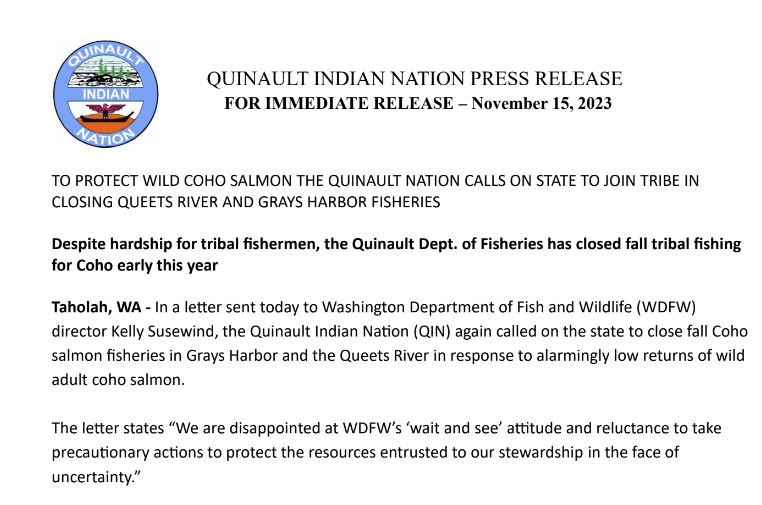
WDFW, QIN Disagree Over Need To Close Grays Harbor, Queets Coho
For the time being anyway, WDFW appears to be holding its ground and holding Grays Harbor and Queets River coho fisheries open despite strong pressure from the Quinault Indian Nation to shut them down.

Tribal comanagers have been very concerned that this fall’s returns to both systems are coming in “alarmingly” low and in late October and again twice this week urged the state agency to close its fisheries for the salmon, saying they were “distressed and frankly mystified over WDFW’s reluctance to take comparable actions.”
But in a response mailed out this afternoon, WDFW Director Kelly Susewind said that stock information his staff has collected “does not suggest a collapse of the 2023 return” and it appears that he will keep angling open on the state-managed sections of the Queets – Salmon and Clearwater Rivers – and Grays Harbor’s Black, Chehalis, Elk, Hoquiam, Johns, Newaukum, Satsop, Skookumchuck, Wishkah, Wynoochee and various other streams under the reduced one-adult-coho daily limit announced November 3.
Susewind said that recreational fishery monitoring in the Humptulips and elsewhere suggests a “higher-than-expected natural component” are returning.
“Currently, the WDFW Wynoochee Trap (in-season update) for coho, suggests that the return has a high likelihood of exceeding our agreed-to escapement goal of 28,506 natural spawning coho in the Chehalis Basin,” Susewind stated, adding, “The Bingham Creek facility currently has 1,318 unmarked coho through the trap as of Management Week 45. The 10 year average unmarked return through that week is 1,149. Current spawning surveys indicate that natural coho are present in significant numbers high in the system. We also have anecdotal information from our fishery monitoring program that there are still fish entering the system with sea lice. We feel all of this information is good news and does not suggest a collapse of the 2023 return. We are aware that the natural coho in other systems on the coast are returning in lower numbers than expected based on the pre-season forecasts. For these reasons, we were supporting the reduced daily limit as it was consistent with other regulations that have been implemented in other Coastal watersheds.”
Susewind’s letter is in response to two letters and a press release in recent weeks from the Quinault Indian Nation that has brought increasing pressure to bear on WDFW. Both entities comanage salmon and steelhead fisheries in the two basins.
In a November 15 press release, QIN President Guy Capoeman noted that tribal fisheries have been closed in response to concerns about the coho run and despite being an economic hardship to tribal commercial fishermen and tribal guides, and he expressed disappointment at WDFW’s “‘wait and see’ attitude,” a reference to a November 3 letter from Susewind to him.

“While we won’t know with certainty how many wild coho will eventually spawn, after analyzing all the information we could muster, we believe precautionary management principles had to be followed. The best available science led us to conclude emergency closures were needed and we are disappointed the state decided against taking similar precautions,” Capoeman said.
An October 30 letter from Capoeman stated that overall commercial wild coho catches were only roughly 20 percent of what was modeled in the preseason and were just 4 percent in the Chehalis, “indicating an alarming steep decline in runs.” In a followup November 14 letter, he said that “we remain convinced that action is needed now to minimize the potential to perpetuate chronic depression of coastal coho stocks that will constrain future treaty and nontreaty fisheries.”
In yesterday’s press release, QIN Fisheries Policy spokesman Cleve Jackson pointed to poor ocean and freshwater conditions and a responsibility to look after the whole environment “for today and tomorrow” in the decision to close tribal fisheries.
In late October, with coho and Chinook coming in below forecast, WDFW reduced salmon limits in two important northwest Olympic Peninsula watersheds, the Hoh and Quillayute. Agency catch reports show few of either species being caught since.
Back to the south, the coho clash between comanagers comes just as they also will be shaping this winter’s coastal steelhead seasons, which in past years and probably this one as well have seen reduced fishing in response to poor wild winter-run forecasts, as well as blanket or near-blanket closures in the Grays Harbor system despite expected surplus returns of hatchery steelhead and available late-returning hatchery coho, a sharp sticking point for state fishermen.
State-tribal disagreements don’t typically break out into the open like this, but it is all is leaving Susewind worried about the path forward in this marriage of comanagement.
“Given the timing of these recent issues, especially with our increasing concern for wild steelhead populations in the Quinault and Queets rivers, WDFW is extremely concerned about this breakdown in the co-manager process, impacts to the resource, and inequities in sharing between the QIN and the State,” Susewind said. “We are therefore again requesting an expedited Government to Government meeting.”
Late fall turbulence on the way to winter.
